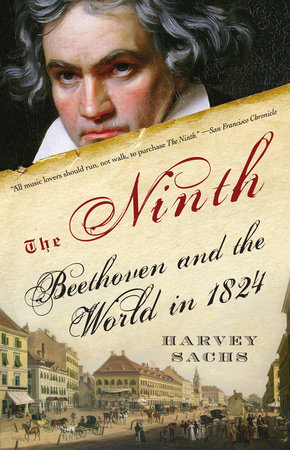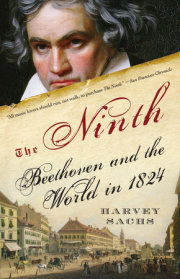The latest news in Vienna”
Reeking, rotting garbage, overflowing from bins: That is what I found when, in November 2004, I pushed open the main door of a massive but anonymous gray stone apartment building in Vienna’s third Bezirk (district) and made my way through a hallway to an internal courtyard. The rectangular four-story building’s façade bears a commemorative plaque put up by the Vienna Schubert Society on May 7, 1924—the hundredth anniversary of the premiere of Beethoven’s Ninth Symphony—as well as another, more recent plaque bedecked with banners dirtied by automobile exhaust, which proclaims that the symphony’s “Ode to Joy” theme has been the European anthem since 1972, when the Council of Ministers in Strasbourg officially adopted it as such. There is no museum in the building at Ungargasse 5, on the northwest corner of a busy intersection; in fact, by going through the entrance door I was trespassing on private property.
In the composer’s day the address was Landstrasse 323, and the building was called the house Zur schönen Sklavin (By the Beautiful Slave Girl); Beethoven lived in it throughout the final months of the symphony’s creation and until shortly after its first performance. His apartment was situated on the top floor—the cheapest one, in pre-elevator days—but he usually received friends and acquaintances at a nearby, no longer extant coffeehouse, Zur goldenen Birne (By the Golden Pear), where he spent many an afternoon. As one contemporary writer put it, “If you have something important1 to tell a Viennese man, you can go ten times to his apartment without finding him in, but if you know which coffeehouse he frequents you’ll meet him there for sure.”
Occasionally, however, people would visit Beethoven at home. Once, during the composition of the Ninth, he invited the poet Franz Grillparzer to the Landstrasse apartment to discuss an opera project; Grillparzer found Beethoven, who was ill at the time, The opera project never came to fruition, and we don’t know what happened to the butter and eggs.
lying on a disordered bed2 in dirty night attire, a book in his hand. At the head of the bed there was a small door which, as I discovered later, communicated with the larder and which Beethoven was, in a way, guarding. For when subsequently a maid emerged from it with butter and eggs he could not restrain himself, though in the middle of a spirited conversation, from casting an appraising glance at the quantity of the food that was being carried away—and this gave me a painful picture of his disordered household.
The composer Carl Maria von Weber visited Beethoven during the same period, and his son later recounted the father’s impressions of “the dreary,3 almost sordid room inhabited by the great Ludwig.” It was “in the greatest disorder: music, money, clothes, lay on the floor, linen in a heap on the unclean bed, the open grand piano was covered in thick dust, and broken coffee-cups lay on the table.” Beethoven tossed all the music off the sofa “and then proceeded to dress for the street, not in the least embarrassed by the presence of his guests.” Another man present on that occasion described Beethoven’s appearance:
His hair dense, grey, standing up, quite white in places, forehead and skull extraordinarily wide and rounded, … the nose square, like a lion’s, the mouth nobly formed and soft, the chin broad and with those marvelous dimples which all his portraits show, formed by two jawbones which seemed capable of cracking the hardest nuts. A dark ruddiness colored his broad, pockmarked face; beneath the bushy and sullenly contracted eyebrows, small, shining eyes were fixed benevolently upon the visitors.
Of another visit to Beethoven, presumably a few weeks later, Weber wrote to his wife that the day would “always remain a most memorable one for me” and that it was “curiously exalting to be overwhelmed with such affectionate attentions by this great man.”
The Vienna of today feels like a museum, or museum-sepulchre, although, thanks in part to the arrival of so many Asian and African immigrants, it does seem a little livelier in the early twenty-first century than it did during the years of grave East-West tension. Even on sunny days a layer of sadness seems to pervade its atmosphere, as if a long winter had passed but no spring had followed. Perhaps a mild form of depression has been and continues to be transmitted from generation to generation—a result of the grayness that followed Vienna’s brilliance, of the sharp cultural decline that followed its long period of splendor—notwithstanding the fact that virtually no one under the age of ninety has adult memories of the city as it was before its Jewish and leftist artists and intellectuals were kicked out or liquidated, and no one at all has adult memories of Franz Josef’s pre–World War I imperial capital. Or perhaps the feeling is now bred in the bone that a city that once counted no longer counts, except as a magnificent repository of memory, and for most people, in Vienna as elsewhere, historical memory is of little importance. What matters is today’s business, and in that sense Vienna seems more humdrum than brilliant.
As for music: Today’s Vienna honors, and profits hugely from, the composers it barely noticed or even rejected when they were alive. Haydn, Mozart, Beethoven, Schubert, Bruckner, Brahms, Schoenberg— the list goes on and on—have monuments, memorial sites, or full-fledged museums dedicated to them, and one can buy chocolates, T-shirts, and souvenirs of every sort with the faces and names of these and other iconic figures emblazoned on them. Tourists who couldn’t distinguish Mozart’s Eine kleine Nachtmusik from Schoenberg’s Verklärte Nacht buy the gewgaws and feel, or so one presumes, that they will be taking something quintessentially Viennese back home with them.
Yet some of the sites of cultural tourism can arouse authentic emotions. Take, for instance, the circumspect little museum dedicated to Beethoven in the Pasqualati House on the Mölker Bastei, a pretty part of town directly opposite the monumental main buildings of the University of Vienna. The composer lived in this apartment house—which has an empty, cold feeling, like much of the rest of the city—at the height of his career, from 1804 to 1808 and from 1810 to 1814, but his fourth-floor walk-up flat contains items from various periods in his lifetime. The rooms no doubt look and smell much better today than they did when they were stuffed with his disorder and filth, and I wondered, when I visited them, whether Beethoven would have laughed had he known that people from all over the world would someday pay good money just to have a peek at the place. Or would he have been astonished, maybe even grateful, to think that people would want to see, and would perhaps even be moved by, some fairly paltry relics of his life?
In any case, if you are interested in Beethoven and are planning a trip to Vienna, by all means visit the Pasqualati House and other sites that contain Beethoven memorabilia, but don’t feel obliged to visit the house on the Ungargasse in which the Ninth Symphony was completed—unless you want to spy on some twenty-first-century garbage bins. More important, don’t expect to be able to visit the Kärntnertor Theater (Theater by the Carinthian Gate), where the symphony’s first performance took place: It was torn down less than half a century after that momentous event. Yet as I stood near the garbage cans of the house Zur schönen Sklavin, I could easily imagine Beethoven—together, presumably, with his sometime amanuensis, Anton Schindler, and with his restless nephew, Karl van Beethoven, who was also his adoptive son—walking past this very spot, then out to the Landstrasse and over to the Kärntnertor Theater, an hour or two before the premiere. At a moderate pace the trip would not have taken more than fifteen minutes, and, depending on which route was chosen, the little group could have passed within a few yards of what is now the Beethovenplatz—Beethoven Square—a quiet, grassy spot dominated by a late-nineteenth-century statue of the scowling master seated on a pedestal and surrounded by bored-looking cherubs and twisting, heroic, winged Michelangelesque figures. Once Beethoven had reached his destination, he would have found himself caught up in the noise and bustle that precede all concerts involving substantial numbers of participants. And he would have been greeted at the stage entrance with much applause and respectful bowing: Although his works were not as popular as those of Gioacchino Rossini—the musical hero of the hour in Vienna as in many other European cities —Beethoven, at fifty-three, was the most revered living European composer. Rossini, who was then thirty-two years old, owed his enormous success to his wonderfully attractive operas and to the sheer beauty of his vocal writing; his music was brilliant but just as accessible in its day as in ours, whereas Beethoven’s was brilliant but difficult—big-caliber artillery aimed at the future. Still, a concert dominated by the premieres of major new orchestral works by Beethoven automatically became a significant occasion, and as no such concert had taken place in a decade local musicians and music lovers had been anticipating the event since it had been announced, several weeks earlier.
Copyright © 2010 by Harvey Sachs. All rights reserved. No part of this excerpt may be reproduced or reprinted without permission in writing from the publisher.










